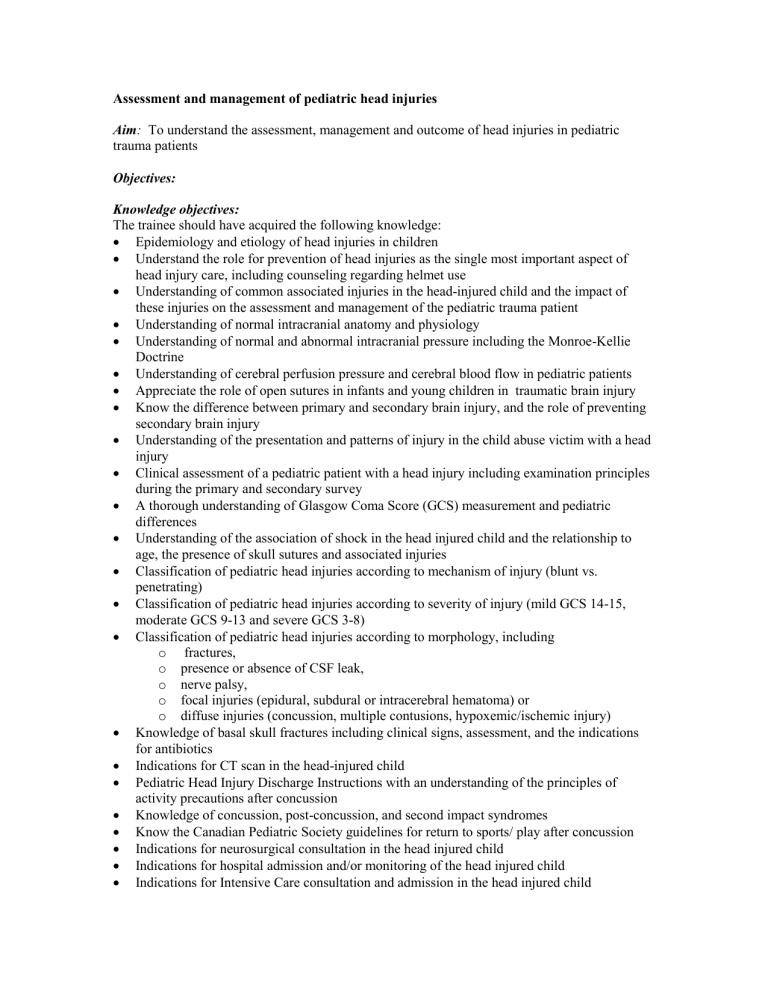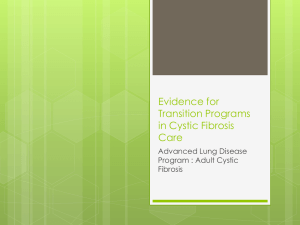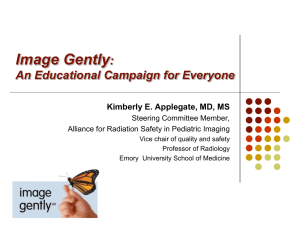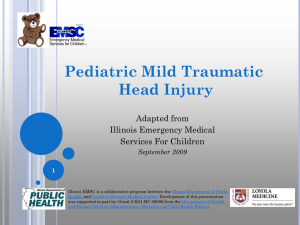Assessment and management of pediatric head injuries

Assessment and management of pediatric head injuries
Aim: To understand the assessment, management and outcome of head injuries in pediatric trauma patients
Objectives:
Knowledge objectives:
The trainee should have acquired the following knowledge:
Epidemiology and etiology of head injuries in children
Understand the role for prevention of head injuries as the single most important aspect of head injury care, including counseling regarding helmet use
Understanding of common associated injuries in the head-injured child and the impact of these injuries on the assessment and management of the pediatric trauma patient
Understanding of normal intracranial anatomy and physiology
Understanding of normal and abnormal intracranial pressure including the Monroe-Kellie
Doctrine
Understanding of cerebral perfusion pressure and cerebral blood flow in pediatric patients
Appreciate the role of open sutures in infants and young children in traumatic brain injury
Know the difference between primary and secondary brain injury, and the role of preventing secondary brain injury
Understanding of the presentation and patterns of injury in the child abuse victim with a head injury
Clinical assessment of a pediatric patient with a head injury including examination principles during the primary and secondary survey
A thorough understanding of Glasgow Coma Score (GCS) measurement and pediatric differences
Understanding of the association of shock in the head injured child and the relationship to age, the presence of skull sutures and associated injuries
Classification of pediatric head injuries according to mechanism of injury (blunt vs. penetrating)
Classification of pediatric head injuries according to severity of injury (mild GCS 14-15, moderate GCS 9-13 and severe GCS 3-8)
Classification of pediatric head injuries according to morphology, including o fractures, o presence or absence of CSF leak, o nerve palsy, o focal injuries (epidural, subdural or intracerebral hematoma) or o diffuse injuries (concussion, multiple contusions, hypoxemic/ischemic injury)
Knowledge of basal skull fractures including clinical signs, assessment, and the indications for antibiotics
Indications for CT scan in the head-injured child
Pediatric Head Injury Discharge Instructions with an understanding of the principles of activity precautions after concussion
Knowledge of concussion, post-concussion, and second impact syndromes
Know the Canadian Pediatric Society guidelines for return to sports/ play after concussion
Indications for neurosurgical consultation in the head injured child
Indications for hospital admission and/or monitoring of the head injured child
Indications for Intensive Care consultation and admission in the head injured child
Initial management principles of the head injured child
Understand the indications and role of the following to prevent secondary brain injury: o Judicious fluid management, o Inotropes o Intubation and ventilation strategies, o Hypertonic saline, o Sedation and paralysis, o Mannitol, and o Anticonvulsants
Know the indications for intracranial pressure monitoring
Understanding of the indications for surgical intervention in the head injured child
Prognosis and outcome for head injuries in pediatric patients
Understanding and recognition of the Second Impact Syndrome
Understanding of the Diagnosis and Clinical Assessment of Brain Death in the traumatized child
Understanding of the indications and process for Organ Donation in the traumatized child declared brain dead
Understanding the large role that injury prevention plays in reducing patient / family suffering and burdens
Skill objectives:
Demonstrate assessment and diagnostic skills in determining the type and extent of head injury
Demonstrate a knowledge of the Glasgow Coma Scale and its modification for the non-verbal pediatric patient
Demonstrate ability to review CT scan of the head in a pediatric trauma patient
Recognition of major intracranial bleeding (epidural, subdural, subarachnoid, intracerebral), and the need to obtain immediate neurosurgical opinion
Recognition of patterns of brain injury in child abuse
Demonstration of helmet removal in the traumatized child with cervical spine protection
Perform adequate resuscitation in a severely head injured child
Demonstrate the ability to manage the airway definitively with appropriate neuroprotection
Recognition of orbital floor fracture with optic nerve injury as a potential reason for unilateral dilated pupil
Knowledge of “AVPU” score as a quick and gross assessment of neurological status







